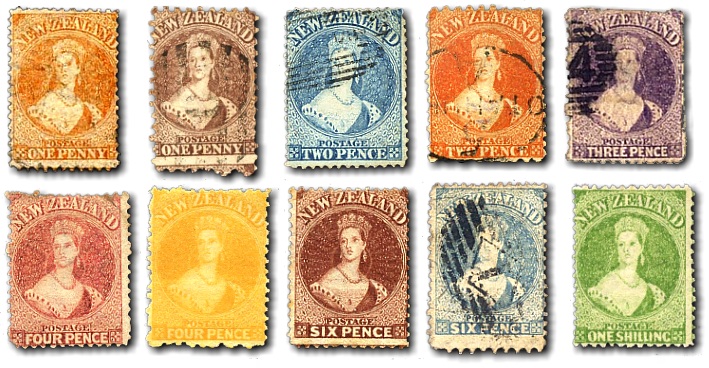
1862 Full Face Queen Victoria - Chalon - Perforated
«previous next»

| Cat. | Mint | Used | ||||||
| 1d | Red | 2a | $405.00 | $99.00 | ||||
| 1d | Orange red variety | 2b | $270.00 | $72.00 | ||||
| 1d | Brown (1871 on) | 2c | $337.50 | $99.00 | ||||
| 2d | Blue | 2d | $247.50 | $45.00 | ||||
| 2d | Orange (1871 on) | 2e | $247.50 | $72.00 | ||||
| 3d | Lilac | 2f | $270.00 | $90.00 | ||||
| 4d | Rose | 2g | $6,750.00 | $558.00 | ||||
| 4d | Yellow | 2h | $540.00 | $315.00 | ||||
| 6d | Brown | 2i | $495.00 | $63.00 | ||||
| 6d | Blue (1871 on) | 2j | $450.00 | $119.00 | ||||
| 1/- | Green | 2k | $540.00 | $198.00 | ||||
| Set of 11 | 2l | $10,024.90 | $1,643.50 | |||||
Several perforation methods were used - including comb, rotary and line perforating machines. The nature of these machines, the design of the stamps, and the technique of sometimes feeding several sheets at once through the perforation machine meant that it is quite rare to find a well centered copy of these stamps where the perforations have not encroached into the design.
The twopence stamp was still the most common and there are many varieties of this stamp available showing the gradual wear of the printing plates and ink and paper variations.
In 1862 the Otago Gold Rush resulted in paper shortages which meant that extremely thin and unsuitable paper was used for the printings that year. As a result, those stamps are thin, almost transparent. The Gold Rush and the switch to compulsory prepaid postage caused a dramatic increase in demand for postage stamps at this time.
A new fourpence stamp was introduced in 1865 to cover the increased cost for faster postage to the United Kingdom via Marseilles. This was initially rose coloured, but was quickly changed to yellow to avoid confusion with the penny red.
From 1871 the colours of the penny, twopence and sixpence stamps were rotated when it was discovered that a chemical reaction with the blue twopence turned the stamp brown so it could be passed off as a sixpence stamp. The penny stamp was now brown, the twopence orange and the sixpence blue.
Bibliography
The Postage Stamps of New Zealand (Volume I)
Edited by R. J. G. Collins and H. T. M. Fathers B.A. B.Sc.
Published 1938 by The Philatelic Society of New Zealand Incorporated
Pages 27 - 94
The Postage Stamps of New Zealand Volume II
Edited by R. J. G. Collins FRPSNZ and C. W. Watts FRPSNZ
Published 1950 by The Royal Philatelic Society of New Zealand Incorporated
Pages 264 - 286
The Postage Stamps of New Zealand Volume IV
Edited by R. J. G. Collins FRPSNZ and C.W. Watts FRPSNZ
Published 1960 by The Royal Philatelic Society of New Zealand Incorporated
Pages 365 - 369
The Postage Stamps of New Zealand Volume VI
Edited by D. E. G. Naish FRPSNZ and K. J. McNaught FRPSNZ FRPSL
Publsihed 1975 by The Royal Philatelic Society of New Zealand Incorporated
Pages 350 - 352
The Postage Stamps of New Zealand Volume VIII
Edited by B. G. Vincent FRPSNZ
Published 1998 by The Royal Philatelic Society of New Zealand Incorporated (ISSN 0-9597883-1-X)
Pages 698 - 701, 748
Catalogue ·
1855 ·
1862 ·
1873 ·
Definitives ·
The Royal Family
Order Form · Currency Converter · Privacy Policy
What to Expect · Contact Us · Links
Order Form · Currency Converter · Privacy Policy
What to Expect · Contact Us · Links
This page was last updated on 07 Jan 2026
All content and images copyright © 2008 - 2026 StampsNZ
All content and images copyright © 2008 - 2026 StampsNZ